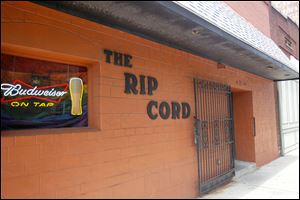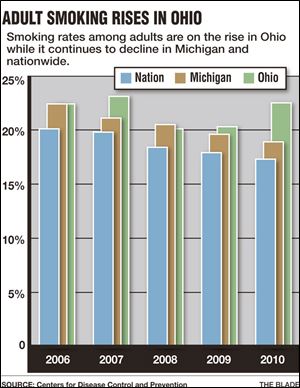
Unpaid smoking fines grow as state funds cut
Local officials vow to keep up enforcement
6/20/2011

This bar on North Erie Street is a defendant in a lawsuit by Lucas County seeking payment of fines. The action is on hold pending decision of a case in Columbus.
As state funding for enforcement of Ohio's smoking ban approaches its end, unpaid fines in Lucas County and throughout the state are piling up.
Less than one third of $2.3 million in fines assessed since the law took effect five years ago has been collected. In Lucas County, roughly $13,000 has been paid -- not even a dent in the $245,500 that's owed.
This is all growing while cash-strapped Ohio is expected to stop paying the Toledo-Lucas County Health Department $125 to investigate each report of a violation of the law forbidding smoking in public buildings.
No money for following up on complaints of alleged smoking violations is contained for any local health department in Gov. John Kasich's proposed $55.7 billion, two-year budget. The state provided $1 million for that purpose this year.
Funding for the "quit line" that helps smokers kick the habit also would be cut by 83 percent.
Still, local health officials say they're not going to back off from enforcing the smoking ban. Toledo in 2003 enacted its ban -- well before the state -- so there's a local history of opposing smoking in public, said Alan Ruffell, the department's environmental health director.
"We're committed to enforcing the rule," Mr. Ruffell said. "We took the lead on the smoking ban. We had our ban before the state ban took effect."
With the enforcement funding cut in the budget, advocates also are calling for financial support from the state. One way to raise $50 million annually for smoking ban enforcement, cessation assistance, and other programs would be to increase the tax on noncigarette tobacco products, including small filtered cigars that have been gaining popularity, said Shelly Kiser, advocacy director for the American Lung Association of Ohio.
Ohio's $1.25-a-pack tax on cigarettes is about 55 percent, while the tax on cigars and other products is 17 percent, Ms. Kiser said. Some lawmakers have expressed interest in the idea of equalizing the taxes, but so far none has championed it, she said.

Delaney’s Lounge on West Alexis Road is one of three bars that together owe more than half the $245,000 in unpaid smoking-violation fines in Lucas County. Opponents of the fines say they should be levied against smokers, not business owners.
"It's a lot cheaper to buy these things," Ms. Kiser said. "The use of these other tobacco products is going up."
Because of the funding declines, local health departments are weighing other options. Hiring someone to do inspections so the department doesn't have to pay existing employees overtime on nights and weekends is among cost-cutting options the Toledo-Lucas County Health Department is considering, Mr. Ruffell said.
The Wood County Health Department may have to turn enforcement over to the state, which would be a disappointment to voters who supported the ban, said Brad Espen, the department's environmental health director.
The Williams County Health Department, Van Wert County Health Department, and 35 other local health departments already have turned enforcement over to the Ohio Department of Health, which currently has one employee spending 1,000 hours a year doing investigations, or about 20 hours a week.
"I'm concerned that we will see an increase in smoking in public places again," said Mr. Espen, adding that smoking-ban complaints in Wood County have declined by more than half. "We've made a great start, and it would be a shame to give up the program."

After falling off in 2008, the percentage of adult Ohio smokers also is on the rise, while the rate among Michigan residents and Americans overall continues to decline, according to 2010 data from the Centers for Disease Control and Prevention.
Last year, 22.5 percent of adult Ohioans smoked, up from 20.3 percent in 2009 and 20.1 percent in 2008. In Michigan, 18.9 percent of adults smoked last year, and 17.3 percent did nationwide, according to the CDC.
The Toledo-Lucas County Health Department and other groups are in the midst of updating local statistics on smoking and other health-related factors. The last study, from 2007, showed 23 percent of Lucas County adults smoked, down from 29 percent in 2003.
Holly Kowalczk, a tobacco treatment specialist at St. Luke's Hospital, said she believes smoking is on the rise in northwest Ohio. Local residents have lost their jobs and health-insurance coverage, and it's cheaper to buy cigarettes than pay for smoking cessation treatment, she said.
"Historically, we're a very high tobacco use area," Ms. Kowalczk said. "As times get tougher, our vices … go up."
Funding for Ohio's ''quit line'' for smokers also could be reduced under the two-year state budget being discussed. There is $1 million for the line in the state's proposed budget for the fiscal year starting July 1, down from $6 million, but it is slated to receive no state support during the fiscal year starting July 1, 2012.
Smoking, however, every year costs Ohio nearly $4.4 billion in health-care expenses and another nearly $4.9 billion in lost productivity, according to the American Lung Association of Ohio.
St. Luke's Hospital continues to have a comprehensive Tobacco Treatment Center, even as state funding for cessation programs largely has dried up. Established about 15 years ago and financially supported by the Maumee hospital, the center addresses prevention, cessation, and intervention in 16 local school districts; provides programs for employers; has a free weekly support group; and does both inpatient and outpatient services.
"St. Luke's has made a commitment to continue doing this," said Ms. Kowalczk, adding that the hope is to spread services throughout new parent company ProMedica.

The Mayfly Tavern in the Point Place area is a co-defendant along with the Rip Cord in a lawsuit seeking payments of fines. Their lawyer says that if bar owners take measures to notify customers of the smoking ban, they should not be fined if customers smoke.
The Toledo-Lucas County Health Department currently has a $52,000 grant from the Ohio Department of Health, which is down from $75,000 last year, said Stuart Kerr, tobacco prevention coordinator.
Last year, the health department started working with Neighborhood Health Association and other medical providers so they can educate patients about the dangers of smoking. School regulations and enforcement are part of the grant's focus this year. The hope is to add cessation programs to the health department's slate, as well as educating students, Mr. Kerr said.
The concern, though, is that all money for programs advocating non-smoking and ban enforcement will dry up, he said.
"I kind of feel that the state is making money by taxing the product, and some of it should be put back into education and enforcement activities," Mr. Kerr said.
Many neighborhood bars and other smoking-ban opponents continue to hold out against the law, which was built around using fines to help pay for enforcement. Among their assertions is that the ban is unconstitutional, as enforcement has focused on fining business owners, not actual smokers as allowed by the law.
Collection rates for Lucas County are at roughly 5 percent. Three Toledo bars -- Rip Cord, Delaney's Lounge, and Mayfly Tavern -- account for more than half of the $245,000 owed in Lucas County.
"Until the state starts collecting the fine money, I'm sure they'll continue to do what they're doing," said Mr. Ruffell of the Toledo-Lucas County Health Department. "That's where the system is weak."
Ban opponents claimed a victory when Toledo's Pour House bar successfully fought a $500 fine, receiving a court ruling the bar could not be penalized because a smoking patron disobeyed. A Pour House bartender had told the patron he couldn't smoke, but the bar was fined after the man left a cigarette burning in a mint tin.
Other lawsuits could have broader implications.
A lawsuit pending before the Ohio Supreme Court involves a Columbus bar, Zeno's Victorian Village, that has not paid mounting smoking ban fines.

If bar owners put signs up about the smoking ban, remove ashtrays, and take other measures to notify patrons that smoking isn't allowed in their establishments, they should not be fined, Mr. Thompson said. Smokers breaking the ban should be fined by health departments, but are not, he said.
"They're just picking and choosing what part of the law they want to enforce," Mr. Thompson said.
Michigan -- which is wrapping up the first year of enforcing its smoking ban -- is not seeing such legal opposition and has had few complaints of violations to its smoking ban.
Michigan's law has some key differences from Ohio's.
Patios in Michigan are not exempt from the smoking ban unless no food or drink is served on them. But Michigan allows smoking in cigar bars, specialty tobacco shops, and in Detroit casinos.
Plus, local health departments in Michigan can order cease-and-desist orders on businesses not complying with the law after other options have been exhausted.
Infractions have not been an issue in Monroe County, where only a couple of complaints have been filed since enforcement of the ban started and no fines have been levied, said Harry Grenawitzke, acting health officer for the Monroe County Health Department.
"It's been going well," Mr. Grenawitzke said. "It's been pretty well accepted."
Across Michigan, only 117 fines have been levied, and there have been less than 1,500 violations reported, said Orlando Todd, tobacco program specialist at the Michigan Department of Community Health.
Unlike other states, citations are not the main thrust of Michigan's smoking ban, Mr. Todd said.
"We're concerned more about education on getting compliance," he said.
Contact Julie M. McKinnon at: jmckinnon@theblade.com or 419-724-6087.